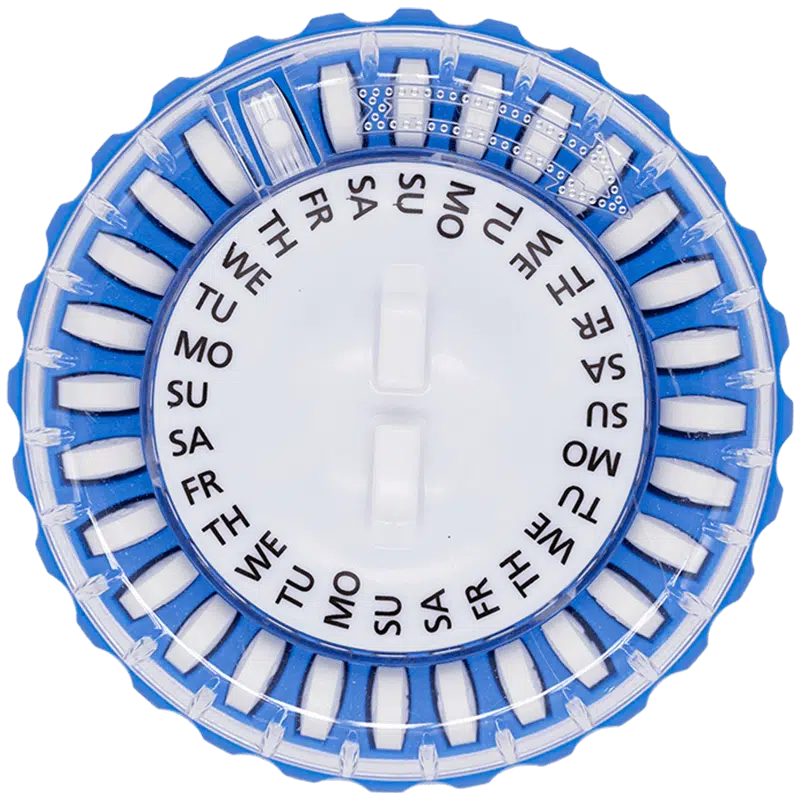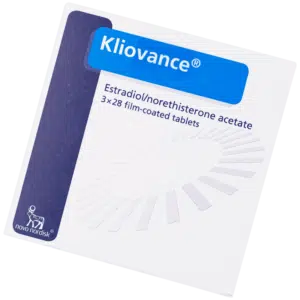The low-dose combined HRT pill.


Kliovance is a pill used in HRT, to help with menopause symptoms. It’s a combined pill with two hormones, and is a lower dose version of Kliofem.
Find the HRT pill that’s right for you. Get expert advice and order Kliovance online.
Kliovance is a pill used in hormone replacement therapy. If you’re going through the menopause and it’s been a year or more since your last natural period, it can help to relieve symptoms like hot flushes and mood swings. It also helps to reduce your risk of osteoporosis, which can rise during the menopause.
Because it’s a combined HRT, which means there are two types of hormones in it, Kliovance is for women with an ‘intact uterus’ (which is a clinical way of saying ‘haven’t had a hysterectomy’).
Kliovance is very similar to another type of HRT pill called Kliofem. The main difference is the dose: Kliovance is basically half the dose of Kliofem, so is better for women who have a higher than usual sensitivity to hormones.
There are two hormones in Kliovance: estradiol and norethisterone. These are an oestrogen and progestogen, and taking Kliovance basically helps to top up your hormone levels as they fall during the menopause.
More specifically, it’s falling oestrogen levels that need replacing when you go through the menopause. When your oestrogen levels naturally drop, this is when you get symptoms like hot flush and mood swings, and your bones can become progressively weaker.
The reason progesterone is given as well is because it helps to balance out the effects of oestrogen in the body. If there’s too much ‘unopposed’ oestrogen in your system, your risk of problems in your womb lining, including cancer, increases. So it’s included in combined HRT as a way of keeping oestrogen in check.
In women taking both estradiol and norethisterone acetate against estradiol alone, the risk of the womb lining becoming unusually thick (endometrial hyperplasia) was much lower in comparative studies.
You can take Kliovance if you’ve not had a hysterectomy, and you’ve not had a natural period for at least a year. It’s a combined continuous HRT, which is what you’ll take if you’re ‘postmenopausal’. If you’re ‘perimenopausal’ (so if you had your last menstrual period less than a year ago’) you’ll normally be recommended sequential HRT instead. In sequential HRT, the hormones delivered in the pill change throughout the month. In continuous HRT, they stay the same.
Kliovance might also be helpful for you if you’ve tried HRT pills with a slightly higher dose and had side effects, because it’s a lighter dose.
Basically, Kliovance is a lower dose version of Kliofem. So if you’ve taken Kliofem and it generally worked well for you, but you had mild side effects, switching to Kliovance may help you get the right balance.

How we source info.
When we present you with stats, data, opinion or a consensus, we’ll tell you where this came from. And we’ll only present data as clinically reliable if it’s come from a reputable source, such as a state or government-funded health body, a peer-reviewed medical journal, or a recognised analytics or data body. Read more in our editorial policy.
The instructions for Kliovance are:
Make sure you read the leaflet before you take Kliovance. If there’s anything you aren’t sure of, let us know.
Hormone replacement therapy lasts for between two and five years for most women. It’s likely you won’t stay on the same treatment the whole time. You might start on a sequential treatment, move onto a continuous treatment, and then it’s common to ‘taper’ your dose (reduce it slowly) before stopping.
So how long you take Kliovance for can vary. Because Kliovance is a lower dose continuous HRT pill, it’s more likely you’ll take it towards the end of your term using HRT. You’ll normally have your symptoms monitored for a while before coming off HRT completely.
When you stop using hormone replacement therapy, it’s normal to have some amount of ‘relapse’ where you get some menopause symptoms, but these usually don't last very long. If they continue for a few months, it’s best to speak to a doctor.

How we source info.
When we present you with stats, data, opinion or a consensus, we’ll tell you where this came from. And we’ll only present data as clinically reliable if it’s come from a reputable source, such as a state or government-funded health body, a peer-reviewed medical journal, or a recognised analytics or data body. Read more in our editorial policy.
Have something specific you want to know? Search our info below, or ask our experts a question if you can’t find what you’re looking for.
HT update: spotlight on estradiol/norethindrone acetate combination therapy. Clinical Interventions in Aging, 3(1), pp.9–16.
Kliovance - Summary of Product Characteristics (SmPC) - (emc).
Great service
Prompt delivery and good communication
Very good service
Very good service
Good straight forward service
Good straight forward service
Excellent service
Excellent service
Kliovance
Excellent and prompt service
Excellent company and reliable...
Great company keeps in touch reliable service speedy delivery means peace of mind. Very pleased....
Great service
Very efficient and speedy approach to diagnosing to supply. Thank you.
Delivered to the post office
Delivered to the post office but they didn't tell me they were going to do that.
Lifesaver
I'm finally back on my menopause meds, a little over 3 weeks, it is so good to be normal again. The violent flushes are under control 😀😀😀happy me xx Delivery excellent and timely 👍👍
Fantastic
I had been having terrible joint and muscle pain but the morning after I put on the first patch I woke up for the first time in months without any pain. I cannot describe what a difference this has made to me.
Changed my life
Tired of having hot flushes at 9pm and then again at 1 am and being awake for most of the night. Feeling edgy with my husband. All that had stopped and I have no hot flushes or being nasty to my family . Yeah - back to my normal self
Love Lenzetto. It is easy
Love Lenzetto. It is easy to apply and makes my menopausal symptoms disappear!!
Excellent
The service from Treated is excellent I would recommend them 100%
Repeat order.
My experience with Treated was yet again very satisfactory. Treated notifies me when my order is due. My repeat order saves me a lot of time and it saves me from checking my diary to make sure I re-order in time. An all round pleasant experience.
Kliofem
Yes, this did the trick from Day 4. Fewer restless nights and hot flushes have virtually stopped. Things are still improving after 2 weeks on Kliofem. Would recommend.
It has really helped me
It has really helped me
No fuss no hassle
Easy to use no fuss no hassle
Excellent service
I can’t fault these guys. I have a consultation online, order & it’s here in a couple of days delivered to my door. Amazing service considering I can never get a drs appt , perfect, will Continue to use for sure!
Straightforward and quick service!
Straightforward and quick service!
Excellent fast service.
Excellent fast service.
Great service
Thank you so much
Good response & delivery
Good response & delivery
Great service
Responsive, efficient service
Exceptional service .
Exceptional service .
Great service.
Great service.
HRT enquiry and delivery
Excellent service, required I’d and a health questionnaire, Identity required and good follow up emails.
Smooth and straight fory
Really excellent service thanks
Game Changer
Great product, no more hot flushes or emotional outbursts 👍 more energy and overall feel much happier.
Very good service. Thanks
Very good service. Thanks
Great service.
Great service.
Good service
Excellent service from Treated, would highly recommend
Quick delivery. No issues. Delivered
Quick delivery. No issues. Delivered on time.
Easy to use and easily absorbed.
This is already prescribed to me by my GP, but there have been instances of shortage and delays. This worried me, so that is why I ordered from you. I am very grateful to be able to do so, I feel more secure about the irregular supply via the GP now. The Lenzetto does fix my HRT symptoms, which make me feel quite wretched, so I hate to be without it. It is easy to use and easily absorbed without a sticky mess such as occurs with a gel.
Happy with service and follow
Happy with service and follow up
Great service
When you can’t get to a doctor but you know what treatment you need, this service is amazing
Great easy service
Got no help from Doctors with Perimenopause after months of begging to be helped. Found Treated, did an quick easy online consultation. Got treatment without hassles and feel so much better. Medication was despatched quickly.
Very efficient
Very efficient
Excellent
Excellent
So far so good
Great service so far. Too early to review the product but no issues at this early stage
Treatment for menopause
The service and advice was 5star as I had no idea where to start with meditation and it was fully explained to me the best options
Great company .
A great company, they supply top notch medication which is delivered quickly and well packed. They email to see how you are getting on with your medicine and keep a track of when your next prescrition is due. Highly recommend this company.
Very good service and speedy
Very good service and speedy delivery, Easy and quick consultation. Treatment is a little pricy though compared to other places .
Great service
Easy to deal with and repeat orders arrive on time with no fuss
Great service will be reordering
Great service will be reordering soon!
A good Company
Have excellent customer care and your treatment/prescription is monitored
Excellent and prompt service
Excellent and prompt service
Very good
Eased my menopause symptoms well.
Excellent service & product
Very happy with the whole process and product, very professional with aftercare.
Medication arrived on time and has helped no end 👍
Needed help with menapose symptoms, my gp was unsympathetic, Treated have given me the support, reliable deliver, no problems with supplies, excellent professional service
Great service ,
Great service ,
Great customer service
I am very impressed with Treated. DPD lost my first delivery and Treated went out of their way to make sure I got a replacement quickly.
Very good service
Very good service
Life changer!
I have suffered with Migraines all my life and have been prescribed every migraine treatment under the sun, unfortunately none of them worked! Starting to go in to the peri menopause they got a lot worse where I would be vomiting every half hour for 16 hours, off work for at least 3 days a month and full migraine type headaches around 15 days a month, the DR’s didn’t seem to know what to do so I decided to self treat! Well my life has changed! I’ve been on them now for roughly six months and not only do I feel amazing I’ve only had two migraines! One near the beginning which was a bad one and one recently which was quite mild in comparison. These patches have truly transformed my life, I would not be without them.
Life saver
Have been taking Kliofem for nearly 3 weeks & honestly my hot flushes have subsided ! I cannot believe it , I suffered terrible with them . It was really embarrassing , my face & arms would go bright red . Wish I had find these earlier . I also feel better in myself , my moods gave lifted . Thank you
professional
really helpful, professional service , would recommend
Easy to use
Easy to use
Highly recommend
Fantastic service. So easy to complete on line with a thorough questionnaire that then recommended different medications. With two days my medication had arrived. The whole process was so easy and pleasant. I had run out of medication couldn’t get a doctors appointment and this was so much quicker and easier. Won’t use anything else now.
Excellent service
Excellent service
Brilliant!
Brilliant product & brilliant service!
Experience
Perfect no hassle a great service dont need to say anymore. I just wish others would be as professional as this company
Everol Sequi patches
Switched from daily tablets to twice a week patches and I honestly feel better after one week. I had stomach issues that I thought was gluten but then dairy and back again but I have been much better than before.
So relieved to have some
So relieved to have some help, thank you
Great Service
Fast and efficient service which was easy to access and expedite.
Excellent
Fabulous product and excellent customer service ⭐️⭐️⭐️⭐️⭐️
Always kept up to date
Always kept up to date with delivery, fantastic service
Delivered on time with no
Delivered on time with no fuss
Very pleased
I am glad I have found this site as it is easier than using the NHS for getting HRT and for someone actually being interested in helping me with my symptoms.
Simple but thorough
Questions asked were as they would be in a doctors surgery. The follow on question directly from a doctor and subsequent adjustment to the suggested medication was professionally handled. Very pleased with my experience.
HRT replacement
Given real options and advice, my first choice was turned down and was explained really well why. Feeling the benefits of Sandrena Gel after just 2 weeks. Thank you, I have my life back
Excellent product, helped me be able to live my life
Only reason not five star is because delivery has become really stressful using Royal Mail . Previous delivery company were fantastic.
Probably to early to tell
Probably to early to tell
Lovely people
Despite a little hiccup, I received my order. Lovely people to deal with. But I found treated more expensive than other online providers. Lot less for the same money as others.
Life changer…
So relieved to receive my hrt (kliovance), thank you so much. KB
All good
Prescription as expected. No problems.
Great treatment
Got these to help with mood etc. after a side effect of sore boobs which disappeared after a few months, I feel so much better.
Very happy with correspondence and
Very happy with correspondence and delivery.
I have had such good
I have had such good service. Thank you.
Fast, courteous service.
Fast, courteous service.
Very helpful
Very helpful staff and quick delivery Thank you
Excellent service
2nd lot of my annual prescription delivered automatically. Effortless. Thank you.
Keeps me feeling much better
Keeps me feeling much better
Fab service!
Fab service!
Excellent
All menopause symptoms relieved - I have my life back 😊
Awesome company 🙂
I receive excellent help and advice, most grateful. 🙂
Excellent Service
This is a professional and efficient company. I will be doing business with them again.
Thumbs up for Indivina
Indivina is working well for me, especially at the higher dose. I’m happy with my treatment 😊
very good
very good
Great service
This is a great service excellent reminders and easy ordering...whilst still monetering your health
Great service. Reliable. Highly recommend
Great service. Reliable. Highly recommend
Great product
Exactly what my body required
Works for me.
I find Oestrogel brilliant, since using I haven't had a hot sweat, and have found my sex life is so much better.
thank you so much. thank
thank you so much. thank you. the service was excellent. can’t fault it,
Brilliant service
I ordered my medication one day and it was delivered the next day thank you
Brilliant service yet again
Brilliant service yet again
organised response. reassuring
organised response. reassuring
Excellent
Brilliant service as always. Well packaged
Easy transaction 😃
Easy transaction 😃
Thank you this site is
Thank you this site is the best, efficient, quick, could not ask for better service
Brilliant service !
Brilliant service !
Good service
Good service
Excellent
Very good service
Evorell Conti
Happy with Evorel Conti
Fast delivery
Very straightforward to order and the delivery was very fast. Pleased with the service, would definitely recommend.
Excellent service
Cannot fault. Very pleased
Excellent service.
Very good retailer easy to order and quick delivery.
Excellent service, couldn’t be better
Excellent service, couldn’t be better
Amazing service, came on the
Amazing service, came on the day they said it would.
Evorel Conti
I am very pleased that Treated prescribed the above form of HRT for me. I have/am undergoing a very difficult menopause, even now. Besides the physical effects the main problem was my unhappy mood and just did not function nearly as well without HRT. My whole family agree that this treatment has visibly improved my whole demeanor. Therefore, I look forward to receiving my regular supply. Thank you so much.
Life saver
Ordered checked and posted within 24 hours. 🥰
Excellent service
Easy ordering process. Fast approval and delivery. Would highly recommend.
Great product
Great product
Great service. One of the
Great service. One of the best I have received.
Fast delivery makes life easier
Reduces any menopausal symptoms
Excellent 👍
Excellent 👍
Everthing very easy,fast posting,great prices,cheaper
Everthing very easy,fast posting,great prices,cheaper than boots.
Eradicates all symptoms
Have been using for a long time. No side effects and alleviates all symptoms of menopause.
great service, thank you
great service, thank you
Great service x
Great service x
Delivered quickly and as advised.
Delivered quickly and as advised. Patches easy to apply and i have very sensative skin and no reaction/irritation.
Efficient delivery
Efficient delivery
Indivina
Brilliant HRT treatment. Couldn't cope without it!
The evorel conti are good
The evorel conti are good and have begun to relieve my menopausal symptoms. Thank-you for the fast delivery. Very good service.
Excellent Service
From start to finish a brilliant professional service. Highly recommended

Registered with GMC (No. 4624794)
Meet Daniel
Registered with GPhC (No. 2202465)
Meet Sanjeda
Registered with GPhC (No. 2070724)
Meet CraigDelivery, consultation, treatment. It’s all included in the price.
| Quantity | Starting from |
|---|---|
| 84 Tablets | £47.95 |
| 168 Tablets | £77.95 Save £17.95 |
| Quantity | Starting from |
|---|---|
| 84 Tablets | £39.95 |
| 168 Tablets | £63.95 Save £15.95 |
| Quantity | Starting from |
|---|---|
| 84 Tablets | £39.95 |
| 168 Tablets | £63.95 Save £15.95 |
| Quantity | Starting from |
|---|---|
| 8 Patches | £47.95 |
| 24 Patches | £87.95 Save £55.90 |
| Quantity | Starting from |
|---|---|
| 8 Patches | £47.95 |
| 24 Patches | £87.95 Save £55.90 |
| Quantity | Starting from |
|---|---|
| 84 Tablets | £51.95 |
| 168 Tablets | £87.95 Save £15.95 |
| Quantity | Starting from |
|---|---|
| 84 Tablets | £51.95 |
| 168 Tablets | £87.95 Save £15.95 |
| Quantity | Starting from |
|---|---|
| 24 Tablets | £58.95 |
| 48 Tablets | £98.95 Save £18.95 |
| Quantity | Starting from |
|---|---|
| 80 Gel | £35.95 |
| 160 Gel | £49.95 Save £21.95 |
| 240 Gel | £61.95 Save £45.90 |
| Quantity | Starting from |
|---|---|
| 12 Patches | £55.95 |
| Quantity | Starting from |
|---|---|
| 12 Patches | £55.95 |
| Quantity | Starting from |
|---|---|
| 84 Tablets | £37.95 |
| 168 Tablets | £59.95 Save £15.95 |
| Quantity | Starting from |
|---|---|
| 84 Tablets | £37.95 |
| 168 Tablets | £59.95 Save £15.95 |
| Quantity | Starting from |
|---|---|
| 28 Tablets | £33.95 |
| 56 Tablets | £47.95 Save £19.95 |
| 84 Tablets | £61.95 Save £39.90 |
| Quantity | Starting from |
|---|---|
| 30 Capsules | £37.95 |
| 60 Capsules | £59.95 Save £15.95 |
| 90 Capsules | £81.95 Save £31.90 |
We know health, but you know you.
Our experts tell you what’s safe, but you decide what’s best.
Answer a few questions and tell us about yourself. Get tailored advice from our clinicians so you can choose better.

Choose your treatment and how often you have it delivered.

We know things change. It’s the nature of life. We’ll check in regularly to make sure your treatment is still right for you.
Pause. Change. Skip. Start again. Any time you like.
Always arrives on time and I’m kept informed of progress.
I have had it previously from my G.P so It worked as expected, extremely well. My problem is an accessing my G.P practice, they put ED well down their list of priorities. I found your service excellent, quick and efficient. I fully intend to continue using it
Shipping is speedy and the product is amazing.
Fast, slick service. Very easy to amend subscription when required.
All good.
Great service
Really helped me
Trusted service and great service - next day delivery and I can rely on them to send regularly.
Ordering was straight forward, tablets delivered promptly and well packaged, and instructions were clear, thanks.
100% recomended.Great service
Excellent service
Excellent delivery. Can’t fault.
Quick and efficient service, delivered discreetly the next day. Thank you.
Effective
Great service, no wait time
Great
Quick assessing for medicine suitability. Quick delivery and good communication throughout.
Straightforward and quick service!
Good however communication could sometimes be better
Easy and good procedure to get treatment
Excellent product
Excellent service!!! Ordered what I needed sent a picture of my prescription and the parcel arrived the next day!!! Will definitely order again and have recommended to others!!!
Fast shipping
Very quick service all round
So quick and simple. Recommend
Great
Very convenient hassle free service.
Easy to use good communication and fast shipping
Great service
Efficient no issues re delivery
Fabulous service
Brilliant service. Not a bad word to say!
It was fast, professional and it's the right med for what I selected in there.
This review requires content. Oh well..
Great service, quite effortless.
Top notch
Brill service
N/a
Excellent service quick and easy to use
Fast and exact order
Superb service and quick delivery 10/10
Excellent service
Thank you for fast delivery
Shipping is extremely quick and satisfiying
Good stuff
Good service
Great fast delivery
Menopause (HRT): Here are some other options.
Oestrogen-only HRT patches and pills. For if you've had a hysterectomy, or used with progestins.
Combined continuous HRT patch. Used it's been more than 12 months since your last period.
Sequential dose patch. Use to manage menopause symptoms if you still have periods.
Comes as a continuous or sequential tablet, depending on whether you're still having periods.
Oestrogen-only HRT to tackle vaginal menopause symptoms.
HRT gel you rub into your skin. It has an easy-to-use pump pack for menopause relief.
Oestrogen only tablet or patch for women who've had a hysterectomy, or used alongside a progesterone in combined HRT.
Generic version of Livial. Hormone-free HRT that can improve mood and libido.
The natural progesterone treatment. Taken alongside oestrogen to relieve symptoms of menopause.
We're making healthcare more about you. Sign up to our newsletter for personalised health articles that make a difference.
Disclaimer: The information provided on this page is not a substitute for professional medical advice, diagnosis, or treatment. If you have any questions or concerns about your health, please talk to a doctor.
We couldn't find what you're looking for.
Here's everything we treat. Or, if you're looking for something we don't have yet, you can suggest something.
If there’s a particular treatment or condition you’re looking for, tell us and we’ll look into it for you.
Submit your question here, or tell us if you’ve found an issue on our site.
We’ll get back to you very soon. We aim to respond to all queries in one working day.
You’re signed up to our newsletter. Keep an eye on your inbox for our latest update.
By clicking 'Subscribe now' you're agreeing to our Privacy Policy.
We’ve sent you an email asking you to confirm your email address.